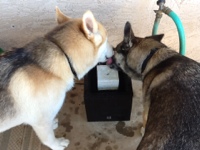 I originally started a true feeding schedule when I got my second dog. One dog was easy to tell when something was wrong but with two it became more challenging.
I originally started a true feeding schedule when I got my second dog. One dog was easy to tell when something was wrong but with two it became more challenging.
My schedule consists of putting down their food at roughly the same times each day. I give them no more than 15 minutes to eat otherwise I’ll remove it until the next feeding. I will keep an eye on the one who didn’t eat to make sure there aren’t any other symptoms that would cause me to become concerned
At one point I did try the free feeding method that I read somewhere and all I got were ants everywhere. Rottweiler’s for example, are more greedy than others and free feeding just wasn’t an option for them.
Over the years a feeding schedule has helped me in recognizing a possible problem. I now have 4 dogs which makes it crucial in knowing who ate in case someone gets sick or if someone is not eating at all.
Another benefit of regularly scheduled meals is knowing that a stool movement isn’t far behind. If you’ve ever had to collect a fresh sample for the vet then you know what I mean!
The first symptom my Australian Shepherd showed before I knew he had heart disease was when I watched him eat. He would eat a little bit and then sit over his food a few minutes then eat a little more and so on. It was weird. Then he would throw-up occasionally. So I took him to the vet and it led to a diagnosis of heart disease. Apparently indigestion is one of the symptoms.
Feeding time is a very important routine. Watch your dogs for a few minutes during and after their meal’s for any strange signs or problems.




